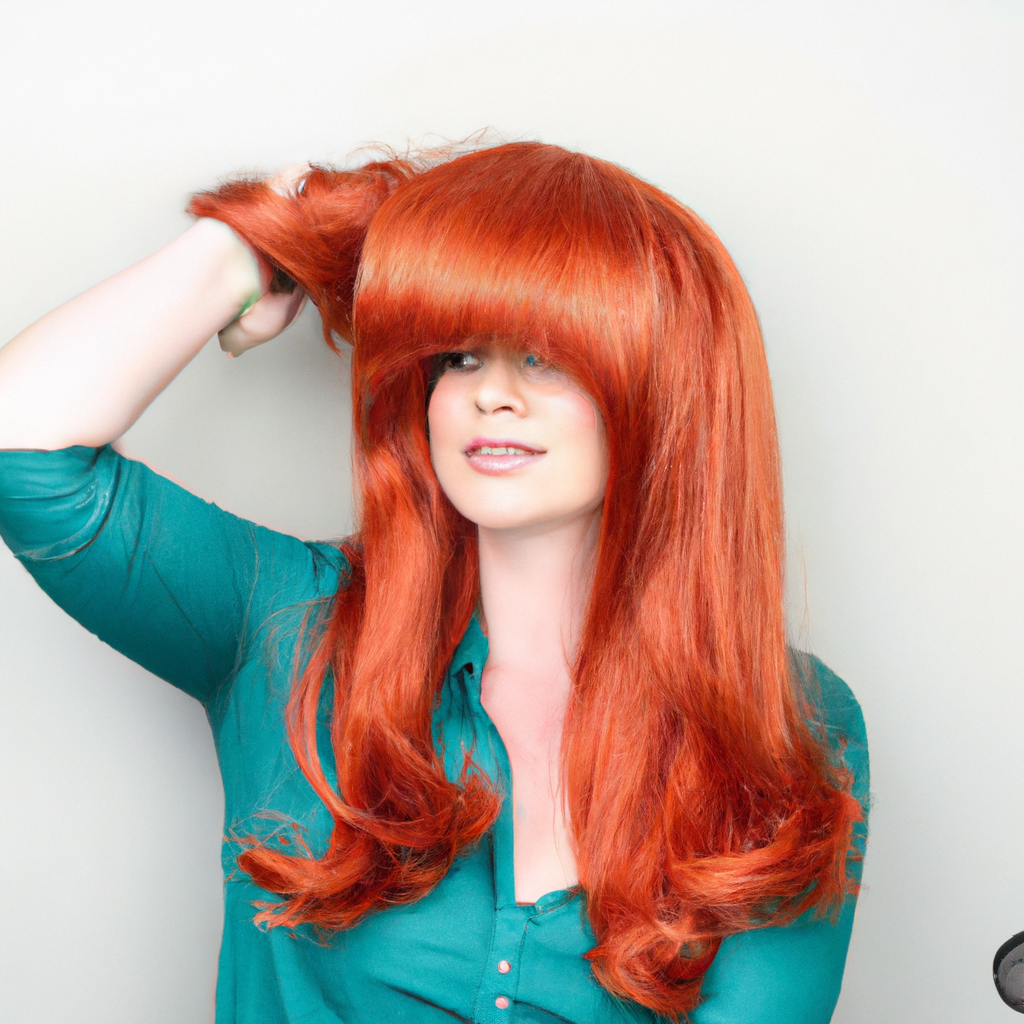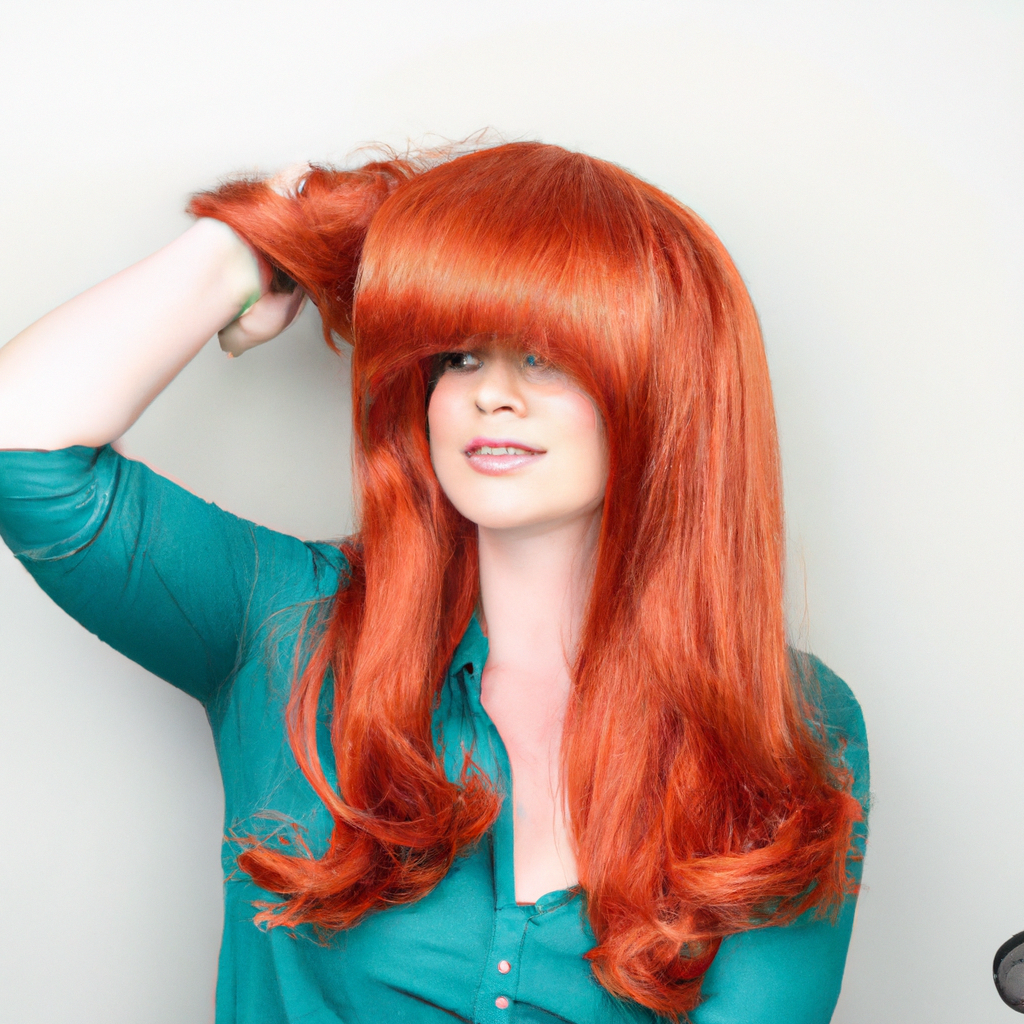Let’s face it, dealing with static can be a real hair-raising experience, especially when it comes to maintaining a ginger wig. Whether it’s for a costume party or a bold fashion statement, keeping that fiery red wig looking flawless is key. But fear not, for I have some handy tips to help you avoid the dreaded static and keep your ginger wig looking sleek and stylish. So, grab your comb and get ready to say goodbye to flyaways and hello to luscious locks that will make heads turn.

Choosing the Right Wig
Opt for a Natural Hair Wig
When choosing a wig, it’s important to opt for one made with natural hair. Natural hair wigs have a more realistic appearance and are less likely to cause static build-up. They mimic the texture and movement of real hair, making it easier to maintain a natural look. Natural hair wigs also tend to be more lightweight and comfortable to wear, allowing for better airflow and minimizing the chances of static electricity.
Select a Wig with Anti-Static Properties
Another option to consider is choosing a wig that has been specially designed with anti-static properties. These wigs are specifically formulated to minimize static electricity and keep your hair looking smooth and static-free. Look for wigs that mention anti-static properties in their product description or consult with a wig specialist to find the best options for your needs.
Avoid Synthetic Wigs
Synthetic wigs, while often more affordable, can be prone to static build-up. The synthetic fibers used in these wigs tend to generate static electricity, resulting in frizzy and unruly hair. If you want to avoid dealing with static in your wig, it’s best to avoid synthetic options altogether and opt for natural hair wigs or those with anti-static properties.
Preventing Static Build-up
Use a Humidifier
Static electricity is more likely to occur in dry environments. To help combat this, consider using a humidifier in the room where you store and wear your wig. A humidifier adds moisture to the air, reducing static build-up and keeping your wig looking smooth and static-free. Simply set up a humidifier near your wig stand or storage area to make a significant difference in reducing static.
Moisturize the Wig
Regularly moisturizing your wig can also help prevent static build-up. Just like your natural hair, wigs need moisture to maintain their natural texture and reduce static electricity. Use a wig-specific moisturizing spray or a mixture of water and leave-in conditioner to hydrate the wig fibers. By moisturizing your wig regularly, you can keep it looking luscious and static-free.
Avoid Heat Styling Tools
Excessive heat from styling tools can lead to dryness in your wig, which in turn increases the likelihood of static electricity. To prevent this, avoid using heat styling tools such as hairdryers, curling irons, or straighteners on your wig. Instead, opt for alternative styling methods that are gentle and don’t expose your wig to excessive heat.
Limit Friction
Friction is one of the main causes of static build-up in wigs. To minimize friction, it’s important to handle your wig with care. Avoid vigorous rubbing or brushing, as this can create static electricity. Instead, gently handle and style your wig to reduce friction and decrease the chances of static.
Washing and Conditioning
Choose the Right Shampoo and Conditioner
When it comes to washing your wig, choosing the right shampoo and conditioner is crucial. Opt for products that are specifically formulated for wigs or for sensitive hair. These products are gentle on the wig fibers and help maintain the wig’s natural texture. Avoid using regular shampoos and conditioners, as they may contain harsh ingredients that can strip the wig’s moisture, leading to more static build-up.
Avoid Overwashing
While it’s important to keep your wig clean, overwashing can strip the hair of its natural oils, making it more prone to static. Aim to wash your wig only when necessary, generally every 8-12 wears or if it becomes visibly dirty. By avoiding excessive washing, you can maintain the wig’s natural moisture levels and minimize static electricity.
Rinse Thoroughly
After shampooing your wig, make sure to rinse it thoroughly to remove any residual product. Product buildup can weigh down the wig and contribute to static build-up. Use lukewarm water and gently run your fingers through the wig to ensure all the shampoo is removed. Thorough rinsing will help keep your wig clean and static-free.
Apply Leave-In Conditioner
After washing and rinsing, apply a small amount of leave-in conditioner to your wig. Leave-in conditioners help to retain moisture in the wig fibers, reducing the chances of static electricity. Apply the conditioner evenly throughout the wig, focusing on the ends where dryness and static are more likely to occur. This extra boost of hydration will keep your wig looking smooth and static-free.
Drying Techniques
Air Dry the Wig
When it comes to drying your wig, air drying is the best method to prevent static build-up. Simply place your wig on a wig stand or a towel in a well-ventilated area. Avoid using hairdryers, as the heat can damage the wig fibers and lead to a higher chance of static. Allow your wig to air dry completely before styling to ensure it maintains its natural texture and static-free appearance.
Avoid Rubbing with Towels
When patting your wig dry after washing, it’s important to avoid rubbing it with towels. Rubbing creates friction, which can generate static electricity. Instead, gently blot the excess water from your wig using a soft, absorbent towel. This gentle patting motion helps to remove moisture without causing static build-up.
Gently Comb Out Wet Hair
While your wig is still slightly damp, it’s crucial to gently comb it out to avoid tangles and static. Use a wide-toothed comb specifically designed for wigs to detangle the wet hair. Start from the ends and work your way up to the roots, being careful not to pull or tug too forcefully. By combing out wet hair with care, you can minimize friction and reduce the likelihood of static electricity.

Brushing and Styling
Use a Wide-Toothed Comb
When it comes to regular brushing, opt for a wide-toothed comb specifically designed for wigs. These combs are less likely to create static and are gentle on the wig fibers. Start at the ends of the hair and work your way up, gradually detangling any knots or tangles. Avoid using regular brushes, as they can create friction and contribute to static build-up.
Avoid Plastic Brushes
Plastic brushes tend to generate static electricity when used on wigs. To prevent this, it’s best to avoid using plastic brushes altogether. Instead, opt for brushes made of natural materials like boar bristles or brushes specifically designed for wigs. These materials are less likely to create friction, reducing the chances of static in your wig.
Apply Anti-Static Products
To further minimize static build-up, consider using anti-static products designed specifically for wigs. These products come in various forms, such as sprays or serums, and help to neutralize static electricity. Apply the anti-static product sparingly, focusing on the ends and areas prone to static. This extra step will help keep your wig looking smooth and static-free throughout the day.
Style with Care
When styling your wig, it’s essential to be gentle and avoid vigorous movements that can create static. Carefully comb or brush the wig, taking care not to apply excessive force or create friction. Smooth down any flyaways or frizz with your hands or a small amount of anti-static serum. By styling your wig with care, you can maintain its static-free appearance and prolong its lifespan.
Storing the Wig
Use a Wig Stand
Proper storage is essential in preventing static build-up in your wig. When not in use, place your wig on a wig stand to maintain its shape and texture. Wig stands come in various sizes and shapes, allowing you to store your wig in a way that minimizes contact with other objects and reduces friction. By using a wig stand, you can prevent unwanted static electricity and keep your wig looking its best.
Keep Away from Static-Prone Areas
When storing your wig, it’s crucial to keep it away from static-prone areas. Avoid storing your wig near electronics, synthetic fabrics, or areas with low humidity, as they can contribute to static build-up. Choose a storage location that is dry and free from excessive heat or friction. By keeping your wig in a static-free environment, you can ensure it stays smooth and tangle-free.
Cover with a Hairnet or Scarf
To further protect your wig from static, consider covering it with a hairnet or scarf while it’s stored. This added layer of protection helps to minimize friction and reduce the chances of static electricity. Make sure the hairnet or scarf is made of natural, breathable materials to promote airflow and prevent moisture build-up. By taking these extra precautions, you can maintain a static-free wig for longer periods.
Managing Static Throughout the Day
Try Anti-Static Spray
If you find that your wig is prone to static throughout the day, consider using an anti-static spray. These sprays are designed to neutralize static electricity and keep your wig looking smooth and manageable. Simply spray a small amount onto your hands and gently smooth it over your wig, focusing on the areas where static tends to occur. This quick and easy solution can provide immediate relief from static issues.
Apply Hairspray or Setting Spray
Another way to combat static is by applying a small amount of hairspray or setting spray to your wig. These products help to keep the hair in place and reduce friction, thereby minimizing static build-up. Opt for lightweight formulas and apply them sparingly to avoid weighing down the wig or creating a sticky residue. By incorporating a hairspray or setting spray into your routine, you can manage static and maintain a polished look.
Avoid Synthetic Fabrics
The clothing you wear can also contribute to static in your wig. Synthetic fabrics, such as polyester or nylon, tend to generate static electricity, which can transfer to your wig. To minimize static, opt for natural fabrics like cotton or silk. These materials are less likely to create friction and reduce the chances of static build-up. By choosing the right clothing materials, you can help keep your wig static-free.
Utilize Dryer Sheets
Dryer sheets are not just for your laundry! They can also be used to combat static in your wig. Rub a dryer sheet lightly over the wig to reduce static. The dryer sheet’s anti-static properties help to neutralize the static electricity, making your wig more manageable. This quick and easy tip can be especially handy when you’re on the go and need an immediate solution to static emergencies.
Dealing with Static Emergencies
Spritz with Water
If you find yourself facing a static emergency and don’t have access to any specific anti-static products, a simple spritz of water can help. Fill a spray bottle with water and lightly mist your wig. The moisture from the water will help to temporarily reduce the static build-up and smooth down the hair. However, it’s important to note that excess moisture can damage the wig, so use this method sparingly and make sure to dry the wig thoroughly afterward.
Apply a Small Amount of Hair Serum
Hair serums are excellent for taming static and adding shine to your natural hair, but they can also be used on wigs. Apply a small amount of hair serum to your hands and gently run your fingers through the wig, focusing on the areas where static is most noticeable. The serum coats the hair fibers, reducing friction and minimizing static build-up. Be cautious not to use an excessive amount of serum to prevent weighing down the wig.
Anti-Static Laundry Spray
In dire static situations, an anti-static laundry spray can come to the rescue. While primarily designed for clothing, these sprays can also be sprayed lightly onto your wig to neutralize static. Follow the instructions on the bottle and ensure the spray is suitable for the materials used in your wig. This method should be used sparingly and only in emergency situations to avoid any potential damage to the wig.
Professional Assistance
Consult a Wig Specialist
If you continue to struggle with static in your wig and haven’t found a solution that works for you, it may be beneficial to consult a wig specialist. A wig specialist can provide personalized advice and recommend products or techniques specifically suited to your wig and hair type. They can also suggest alternative wig options if static remains a persistent issue. Don’t hesitate to seek professional assistance if needed; they have the expertise to help you overcome static challenges.
Consider Wig Reconditioning Services
If your wig is old or has been experiencing persistent static build-up, you may want to consider wig reconditioning services. These services specialize in rejuvenating and restoring wigs, including addressing static issues. Wig reconditioning typically involves deep cleaning, moisturizing, and using advanced techniques to reduce static electricity. Contact reputable wig reconditioning services in your area to inquire about their processes and schedule a consultation to determine if it’s the right option for you.
Conclusion
Static electricity in a ginger wig can be frustrating, but with the right techniques and products, you can minimize static build-up and keep your wig looking smooth and natural. By choosing a natural hair wig or one with anti-static properties, preventing static build-up with humidifiers and moisturization, using the correct washing and drying techniques, and employing anti-static products, you can successfully manage and reduce static in your wig. Storing your wig properly, managing static throughout the day, and knowing how to handle static emergencies are also important aspects of maintaining a static-free wig. Don’t hesitate to seek professional assistance or explore wig reconditioning services if you need additional support. With these tips and techniques, you can confidently enjoy your ginger wig without the annoyance of static electricity.
